Cincinnati Streetcar Opens
New system, similar to Milwaukee project, drawing 3,000 daily riders.
Following years of controversy, Cincinnati’s streetcar, known as the Cincinnati Bell Connector, opened to the public on Friday, September 9th. The 1.8 mile line connects the stadiums and development on the city’s waterfront with Downtown and the city’s Over-the-Rhine neighborhood to the north. Along the way the route passes a number of office buildings, apartments, museums and other amenities.
The modern streetcar system, owned by the City of Cincinnati, utilizes five vehicles manufactured by CAF USA, each capable of holding up to 150 passengers. The system operates as a 3.6 mile loop, with the tracks split between parallel, one-way streets.
The first week of revenue service exceeded projections, with just over 3,100 daily riders. Long-time project advocate John Schneider noted that “people are using it for everyday things instead of as an amusement ride for tourists.” Another project advocate, Derek Bauman, told Next City that “our first goal was dual purpose: economic development and to have an urban circulator. It becomes more about transportation with the coming expansions.”
Service runs 6:30 a.m. until midnight on weekdays, and until 1 a.m. on weekends. Headways range from 12 minutes between vehicles at peak times to 15 minutes between vehicles on off-peak operating hours.
Future extensions of the system are planned to the city’s Uptown neighborhood where it can connect with the University of Cincinnati.
Unending Controversy
The project was in cast into jeopardy in 2013 when outgoing mayor Mark Mallory was replaced by John Cranley. Mallory, a champion of the project, was ineligible to run for re-election because of Cincinnati’s term limits barring mayor’s from serving more than two consecutive terms. Cranley attempted to kill the $148 million project upon being elected and issued a work stoppage shortly after taking office.
The council-member-turned-mayor was ultimately unsuccessful in his bid to kill the streetcar because of the need to repay the federal government millions of dollars in already spent funds and support for the project on the council. Partially acquiescing to Cranley’s demands for private money for streetcar operation, the Haile U.S. Bank Foundation pledged up to $9 million over the system’s first ten years of operation to cover any shortfalls.
For more information on the years of political fighting around the project, see the Cincinnati Enquirer’s comprehensive timeline.
Milwaukee Similarities
The similarities between the Cincinnati Bell Connector and the Milwaukee Streetcar are extensive. Both projects have faced substantial opposition from Republican governors with Presidential ambitions, with John Kasich pulling $52 million in Ohio transportation funds previously designed for the project. The projects have both been subject to lengthy legal fights over relocation of utilities that have substantially increased project costs, with Duke Energy ultimately prevailing in Cincinnati. The projects were both recipients of approximately $50 million federal grants, essential to their early approvals. And much to the chagrin of project advocates in both cities, both of the streetcar systems were extensively delayed.
Political opposition to the Cincinnati project has been far more effective, with project opponents twice succeeding in getting anti-streetcar referendums placed on the ballot.
Perhaps foreshadowing what might be in the Milwaukee Streetcar’s future, the Cincinnati system was branded as the Cincinnati Bell Connector following a $3.4 million, ten-year naming rights deal between the city and telephone company Cincinnati Bell. Milwaukeean’s, get ready for the Miller Lite Line.
In another revenue making opportunity for the project that is sure to be a hit with Milwaukeeans, a four-hour charter costs $1,250. Unfortunately for beer-loving Wisconsinites, no alcohol is permitted on the vehicle.
Photos
Photos of the opening day of Cincinnati Bell Connector operation provided by UrbanCincy.com. For more coverage, see their website.
Past Streetcar Coverage
- Council Okays Streetcar to Bucks Arena – Jeramey Jannene – July 7th, 2016
- $6.5 Million in Streetcar Savings – Jeramey Jannene – February 26th, 2016
- Donovan Lies About Streetcar Suit – Jeramey Jannene – February 15th, 2016
- BID Sells Streetcar-Related Development – Jeramey Jannene – January 15th, 2016
- Pennsylvania Company Wins Streetcar Contract – Jeramey Jannene – November 13th, 2015
- City Accepts $14 Million Federal Streetcar Grant – Michael Horne – October 29th, 2015
- Anti-Streetcar Petition Dies – Bruce Murphy – August 28th, 2015
- Scott Walker Aids Milwaukee Streetcar – Jeramey Jannene – July 13th, 2015
- Streetcar Construction Starts in October – Jeramey Jannene – July 10th, 2015
- The Strange Politics of Anti-Streetcar-ites – Bruce Murphy – June 18th, 2015
- Anti-Streetcar Petition Drive Fails – Bruce Murphy – March 5th, 2015
- Streetcar Signing Is Quite a Celebration – Michael Horne – February 13th, 2015
- Milwaukee Streetcar Approved – Jeramey Jannene – February 10th, 2015
- Who’s Lobbying for the Streetcar – Bruce Murphy – February 5th, 2015
- Will Streetcar Help the Inner City? – Bruce Thompson – February 4th, 2015
- City Attorney Says Streetcar Petitions Might be Moot – Bruce Murphy – January 30th, 2015
- Millennials And The Streetcar – Bruce Thompson – January 27th, 2015
- Streetcar Responses Show Wide Support – Jeramey Jannene – January 22nd, 2015
- Streetcar Approved, but Held – Jeramey Jannene – January 21st, 2015
- Koch-Funded Group Backs Anti-Streetcar Drive – Bruce Murphy – January 20th, 2015
- Streetcar Backers Say They Have the Votes – Jeramey Jannene – January 20th, 2015
- Who is Funding the Anti-Streetcar Effort? – Bruce Murphy – January 20th, 2015
- Will Anti-Streetcar Referendum Succeed? – Bruce Murphy – January 9th, 2015
- The Story Behind the Streetcar Referendum – Michael Horne and Bruce Murphy – January 8th, 2015
- Council Delays Streetcar Until January – Jeramey Jannene – December 16th, 2014
- Committee Takes No Action on Streetcar – Jeramey Jannene – December 10th, 2014
- Committee Approves Milwaukee Streetcar – Jeramey Jannene – December 9th, 2014
- RACM Approves Tax Funding for Streetcar – Michael Horne – December 8th, 2014
- How to Sell the Streetcar – Michael Horne – November 28th, 2014
- Next Stops for the Streetcar – Michael Horne – November 24th, 2014
- Barrett Moving Forward with Streetcar – Jeramey Jannene – November 18th, 2014
- Who Will Be Streetcar Operator – Michael Horne – May 8th, 2014
- A Streetcar Named Cooperation? – Dave Reid – April 27th, 2014
- How a Streetcar Spurs Development – Angie Schmitt – November 3rd, 2013
- Streetcar Social – Michael Horne – September 12th, 2013
- Mayor Says Streetcar is a “Trojan Horse” – Michael Horne – April 17th, 2013
- Whoops, We Changed Our Mind – Dave Reid – September 27th, 2012
- Battle of the Bobs: Donovan vs Bauman Streetcar Press Conference – Jeramey Jannene – May 18th, 2012
- Important Hoan Bridge and Milwaukee Streetcar Meetings This Week – Dave Reid – November 14th, 2011
- Milwaukee Streetcar Passes Common Council – Jeramey Jannene – July 26th, 2011
- Keep the Milwaukee Streetcar Moving Forward – Jeramey Jannene – July 8th, 2011
- Milwaukee Streetcar at Apex – Jeramey Jannene – June 16th, 2011
- Milwaukee Streetcar Takes Key Step Forward – Jeramey Jannene – May 6th, 2010
- Milwaukee Streetcar Meeting This Thursday – Jeramey Jannene – October 5th, 2009
- Milwaukee Streetcar Routes Unveiled by Mayor Barrett – Jeramey Jannene – September 21st, 2009
- Milwaukee Streetcar Round-Up – Jeramey Jannene – April 19th, 2009
- Vote for your Favorite Milwaukee Streetcar Route – Jeramey Jannene – March 25th, 2009
- Design Your Own Streetcar Route – Jeramey Jannene – March 23rd, 2009
- Streetcars Coming to Milwaukee – Dave Reid – March 14th, 2009
More about the Milwaukee Streetcar
For more project details, including the project timeline, financing, route and possible extensions, see our extensive past coverage.
- FTA Tells Milwaukee to Crack Down on Fare Evasion — Even Where Fares Don’t Exist - Graham Kilmer - Dec 12th, 2025
- Alderman, State Allies Seek Federal Help to Kill the Streetcar - Jeramey Jannene - Oct 28th, 2025
- Streetcar Service Suspended Following Truck Crash - Jeramey Jannene - Oct 21st, 2025
- One Alderman’s Quest To Defund The Streetcar - Jeramey Jannene - Oct 18th, 2025
- Another Streetcar Collision - Jeramey Jannene - Jun 27th, 2025
- Streetcar Hit By Apparent Red Light Runner - Jeramey Jannene - Jun 16th, 2025
- Streetcar Will Run On Consolidated Route During Summerfest - Jeramey Jannene - Jun 11th, 2025
- City Hall: Milwaukee Must Replace Failing Streetcar Switches - Jeramey Jannene - Feb 24th, 2025
- Streetcar Confronts Limited Funding, Operations Challenges - Evan Casey - Jan 22nd, 2025
- Council Kills Streetcar’s ‘Festivals Line’ - Jeramey Jannene - Jul 31st, 2024
Read more about Milwaukee Streetcar here
Eyes on Milwaukee
-
Church, Cupid Partner On Affordable Housing
 Dec 4th, 2023 by Jeramey Jannene
Dec 4th, 2023 by Jeramey Jannene
-
Downtown Building Sells For Nearly Twice Its Assessed Value
 Nov 12th, 2023 by Jeramey Jannene
Nov 12th, 2023 by Jeramey Jannene
-
Immigration Office Moving To 310W Building
 Oct 25th, 2023 by Jeramey Jannene
Oct 25th, 2023 by Jeramey Jannene
Transportation
-
Congestion Pricing Cuts Air Pollution in New York City
 Dec 14th, 2025 by Jeff Wood
Dec 14th, 2025 by Jeff Wood
-
FTA Tells Milwaukee to Crack Down on Fare Evasion — Even Where Fares Don’t Exist
 Dec 12th, 2025 by Graham Kilmer
Dec 12th, 2025 by Graham Kilmer
-
Will GOGO’s Bus Service Ever Get Going?
 Dec 9th, 2025 by Jeramey Jannene
Dec 9th, 2025 by Jeramey Jannene


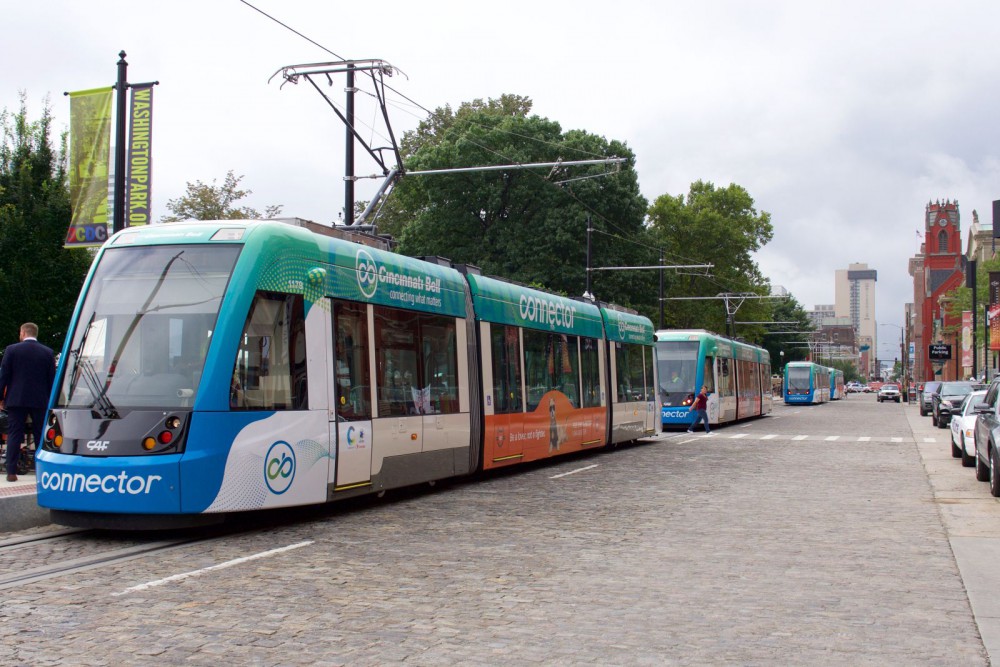
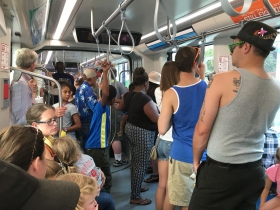
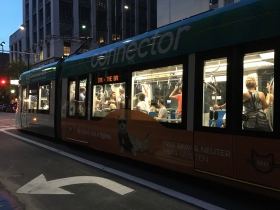
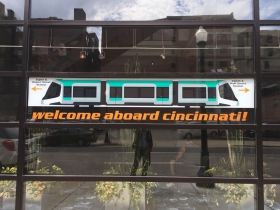
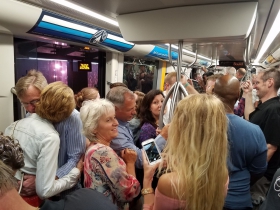
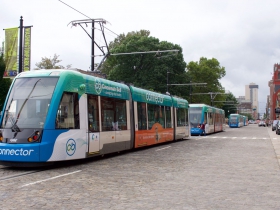
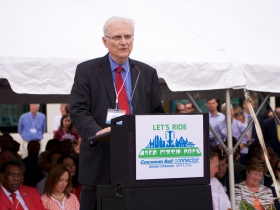




















I am sure know one in the audience cares about real revenue to provide long term cost structures for the trolley service but of the 3,000 riders a day. How many have Cincinnati Transit passes of which you get no income for the service. Of the 3,000 riders how many are getting on and off and being counted twice or thrice. I wish them well it well cost government a fortune.
The Cincinnati streetcar started running Friday before last. For the first three days, it was free (no fares charged), and it started charging regular fares last week Monday.
It carried over 50,000 people (for free) on those first 3 days, but what happened once it was no longer free? Since they started charging fares, ridership continues to exceed projections—averaging 3,185 people daily last week Monday thru Thursday, vs pre-opening projections of 3,000/day.
Then starting last Friday, things got crazy and the streetcar carried over 29,000 people Friday–Sunday (vs pre-opening projections of 5,490). Yesterday, for example, it carried nearly ten times what was projected (9,639 actual vs Sunday projections of 990).
It actually broke even (fares exceeded operating costs) over the weekend, something that nobody anticipated!
http://www.cincinnati-oh.gov/streetcar/news/29-000-rides-on-cincinnati-bell-connector-during-oktoberfest-weekend/
Also: http://www.slate.com/blogs/moneybox/2016/08/02/kansas_city_s_streetcar_is_counting_crazy_high_ridership.html
TOM D. If all your facts are true then at first glance maybe it isn’t as bad as other cities urban systems. Still, I think it would be cheaper for the city to provide free Uber rides instead.
Jason (post 4), what happens when Uber goes belly-up? Uber lost over $1.25 billion (yes, billion with a “B”) in just the first 6 months of 2016. And that came after losing $2 billion last year.
http://money.usnews.com/investing/articles/2016-08-29/uber-ipo-losing-luster-after-a-12-billion-loss
And it’s not just Uber’s financial instability, its what Uber does to traffic volume.
Unlike Uber, transit reduces the number of vehicles on the road. (A streetcar is about as long as 4 automobiles, but can carry 100–200 people.)
Uber doesn’t reduce traffic at all; if anything, it worsens traffic as empty cars drive to their next passenger (or, even worse, cruise aimlessly waiting to be assigned a new trip).
Finally, while Uber is fine for picking up a few people at a time, its model is useless for picking up large crowds (after concerts, games, etc). If thousands of people leaving a concert all try to take Uber, it simply wouldn’t work. Even 1,000 cars lined up bumper-to-bumper would stretch about 3 miles. How would you possibly find your Uber car?
By contrast, the Minneapolis light rail system can board about 200/minute from a single platform after an event (8,000 passengers within 40 minutes after a concert in August).
It will be interesting to see what effect this has on Downtown Cincy. They have a lot of vacant store fronts along the line of where the street car travels. Cincy is the perfect city scenario to test the “pro” street car theory.
“hey have a lot of vacant store fronts along the line of where the street car travels”
I kind of wish Milwaukee would’ve taken a similar approach. Have the street care travel through areas that need the extra development but are still close enough to the booming areas.
Michigan and Lincoln Memorial and travel to and eventually up either FDL or King Drive.
Sorry, Jason, facts usually win against unsubstantiated conjecture. Tom D has provided data and links to support the argument that new mass transit is working.
As to the con argument, you’ve posted a platitude-laden, grammatical nightmare that attempts to be patronizing. Yeah, you’re really gonna convince me not to take the boondoggle trolley.
Casey, the extension up 4th St, with plans to go to Bronzeville, basically does just that. We’ll see if it does much to spur development in the area… I’m skeptical.
Dude- its not going to get even close to going up FDL. Midtown to Downtown would be a practical route that would help a the community and help with the feelings that Downtown (or really east of I43) are an island onto its self.
Sean (post 6),
Cincinnati’s streetcar-induced building boom started back in 2008 when a streetcar referendum passed. Coldwell Banker reported getting inquiries beginning the very next day.
http://usa.streetsblog.org/2013/10/28/new-wave-of-development-follows-streetcar-construction-in-mid-sized-cities/
I think Milwaukee’s current downtown building boom is due to the streetcar, too. I think it’s no coincidence that the NML residential tower (1 block from the streetcar)was announced just a few months after the streetcar was approved. Some apartment websites already list their proximity to the streetcar as a selling point.
There is lots of under-developed land downtown on or near the streetcar (e.g. Park East freeway, the parking lot at 4th & Wisconsin, train station vicinity including the post office, and the site of that new NML residential tower).
And it’s not just new construction; existing structures are also increasing in value. Consider this timeline:
• Oct 2014 Grand Avenue mall sells for $16.5 million
• Feb 2015 Common Council approves Streetcar
• Dec 2015 Grand Avenue sells for $24.6 million
Dudemeister, I hope your right. Maybe, the Millenials and Generation Z will prove me wrong. They seem not to like to own vehicles. The mathematics though seem clear. No one expects the trolley to turn a profit best case scenario is maybe the city will find enough sponsorships to only bleed several million dollars a year out of the tax coffers. It just doesn’t seem to go where the millenials are. For example, US Bank building three blocks, NML five blocks, a large swath of young workers do not even live on the route, instead they live closer to Brewer’s Hills and Schlitz Park.
Do you not leave Glendale much Jason? Millennials are not concentrated in just Brewer’s Hill and Schlitz Park. That statement makes no sense.
Sean, I live here and it’s really easy to tell the effect the streetcar has already has. Numerous small shops, restaurants, an explosion of apartments available has all happened along the line and spread to the surrounding blocks. The transformation is amazing.
I think OTR *may* have been developed without the streetcar but IF it had I doubt that it would’ve been at the breathtaking pace it’s on now. For reference, there are a few blog posts out there that have pictures of pre-streetcar OTR to current. Amazing to see the transformation (and in such a short time.) I only regret not buying earlier.
Jason (post 11)
You said the streetcar would be 5 blocks from NML and 3 from US Bank. You don’t seem to understand the streetcar routes. The streetcar’s 2nd route (opening in 2019) runs along Michigan, right past the back of US Bank and one block from NML.
And Tom D by then the NML residential tower will be open right?
Vincent Hanna (post 14): I assumed Jason was referring to the NML office buildings on Wisconsin Avenue. Those buildings will be on the streetcar’s Lakefront route.
The NML residential tower (which is supposed to be open by spring, 2018) is near both streetcar routes.
NML residential tower: Jackson & Wells
Original streetcar route: Jackson & Kilbourn (one block north)
Lakefront streetcar route: Milwaukee & Wells (2 blocks west)
Oh OK. Thanks. Sounds like a lot of Millennials will be living very close to the streetcar. Good things.
The Cincy route is stated to include stadiums, which ours doesn’t nor does it have proposed. My question for everyone is, without including the MU or UWM campuses nor Miller Park are we destined to have struggling ridership before we get any of the proposed extensions in?
@Chris The Milwaukee Streetcar is planned to go right past the Bucks arena (though I’m not sure that’s important or not).
The following is cribbed and edited down from the website “Reason.com”. No comment beyond the obvious: it depends whose propaganda one listens to.
Cincinnati’s controversial streetcar line has already been plagued by problems and bad omens. First, a car was nonoperational on opening day. Then, a bomb threat forced the line’s shutdown. Other problems faced by the streetcar in its first week include credit-card machines not working at some ticket kiosks and passenger-count sensors failing, leaving officials to merely estimate the number of opening-weekend riders. And the streetcar manager demanded an extra $20,000 from the city if it wanted more than two cars to run during Cincy’s huge annual Oktoberfest festival.
It’s unclear who exactly the streetcar—which covers a scant 3.6 square-mile portion of downtown—is meant to serve. The 18-stop route now connects areas where downtown residents and employees can either easily walk or bus or have little reason to travel between, and where visitors from the suburbs (who will already have to drive in) can find ample parking. The route was initially supposed to expand uphill toward the University of Cincinnati campus, but that plan was scrapped after Kasich pulled state funding.
With the original route, Cincinnati had originally estimated a building and prep cost of $110 million. The project was to be completed in three years. Nine years later, the ultimately much smaller route wound up costing the city $148 million, of which around $45 million came in the form of grants from the federal government.
Cincinnati will pay the Southwest Ohio Regional Transit Authority (SORTA) $4.2 million per year to manage the streetcar, which is operated and maintained by French company Transdev. Ramping up service during special events will cost extra—something city officials were surprised to learn earlier this week.
City Manager Harry Black announced that a compromise had been reached such that SORTA would get $7,000 in money left over from its streetcar-opening budget to run an additional two cars on Oktoberfest weekend. Advertising Vehicles, the company that sold ads on and in the streetcars, will make up any operating expenses not covered by the city money or that weekend’s ticket revenue.
SORTA, a taxpayer-funded state agency which also runs bus systems, projects a $1.3 million budget shortfall this year, amid declines in bus ridership and fare revenue, and has begun firing staff and postponing projects. So far, SORTA’s management of the streetcar isn’t inspiring much confidence in its ability to manage this public-transit option any better.
Cincinnati officials have offered little in the way of estimated economic impact from the streetcar. According to the Cincinnati Enquirer, they repeatedly refused requests to talk about property values along the streetcar line, which an Enquirer analysis found had changed little since 2007.
Cincinnati’s streetcar follows troubled streetcar initiatives in other cities—including Atlanta and Washington, D.C, recently. Washington has given more than $500 million in federal money to streetcar projects over the past eight years.
There will be a streetcar to the Couture, which will get people to museums and Summerfest. But are there plans to run buses north along the lakefront?
With the fluctuations of lakefront traffic, a streetcar route would not make sense. But without any mass transit along the rest of the lakefront, the streetcar will serve narrowly defined users and stakeholders. It will not serve the broader community, at least at the lakefront.
Why are we presuming there will be a route beyond phase one? There will be no money from the state, city or the county to breathe life in to phase two?
Jason (post 22), both phase 1 (train station to Prospect/Ogden) and phase 2 (Couture) are funded. The construction money is already there and the construction contracts have already been awarded.